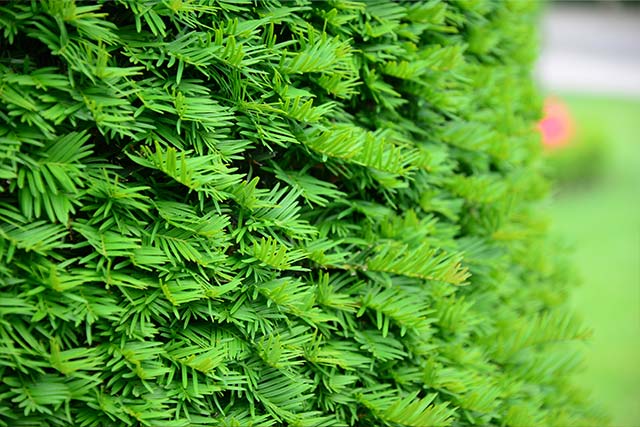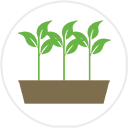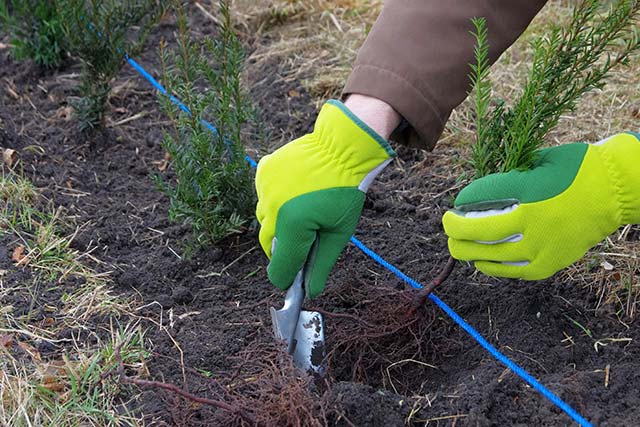English yew hedges, otherwise known as "taxus baccata", are a an evergreen species featuring dense, dark green foliage and red, berry-like arils.
The yew's adaptability to various soil types and resistance to different weather conditions make it a popular choice for formal hedges and topiary.
Growth rate: Medium 20-40cm per year
Overall height: Medium up to 5 metres
Position: Full Shade, Full Sun, Exposed, Sheltered
Root Types: Bare Root, Instant Hedging, Pot Grown, Root Balled
Choose from our wide range of English Yew Hedge sizes and root types, or browse our other varieties of Yew Hedging plants.
Check our range of Yew Hedging or our other popular varieties of hedge that can be used as a great alternative to English Yew Hedge.
Yew hedges, or Taxus Baccata as they are scientifically known, are a popular hedging plant in British gardens. This perennial evergreen species is characterised by its vibrant, dark green foliage and distinctive red arils that resemble berries, adding a touch of colour to its deep green backdrop.
One of the key attributes of yew hedge is it's remarkable adaptability. These plants have the ability to thrive in a variety of soil types and weather conditions, making them a highly versatile choice for gardeners.
Whether planted in full sun or shade, or in exposed or sheltered positions, yew hedges maintain their lush appearance and robust health.
Yew hedges are known as being slow growing, with an average growth rate of 30cm each year, reaching a height up to 5 metres. This makes yew an excellent choice for any type of formal hedge and topiary applications.

Depending on the specific cultivation method, yew hedging can be found as bare root, root ball, pot grown or instant hedging, offering solutions for both immediate and long-term garden design.

Bare root hedging plants are an affordable and efficient choice for landscaping projects, as they're sold without soil around their roots. They're typically available between November and April, which is considered the dormant season for most plants.
This type of yew hedge plant is perfect for those who are willing to provide a little extra care and attention in the initial stages. Bare root hedging requires thorough watering during dry periods, especially within the first year after planting.

Pot grown yew hedge plants offer flexibility and convenience for gardening enthusiasts and professional landscapers alike. As they are cultivated and sold in pots, these plants can be planted at any time of the year, unlike their bare root counterparts.
This makes them a perfect choice for those who wish to undertake landscaping projects outside of the traditional planting season. Furthermore, pot grown yew typically require less initial care after planting, as their root system is already well-established.

Root balled yew hedge plants are often a favoured choice for those seeking an immediate impact in their landscaping projects. These plants are cultivated in fields for several years, allowing them to develop a robust and healthy root system, before being carefully lifted from the ground with a large ball of soil protecting their roots.
One of the key advantages of root balled plants lies in their maturity. Once they are lifted with their roots intact in a soil ball, root balled yews can be planted throughout the winter season, from November to April.

Instant hedging plants provides an immediate solution for those seeking privacy or a distinctive aesthetic in their garden. These ready-grown hedges are delivered as mature plants, offering instant lush foliage and the characteristic red arils that define the English yew.
This type of yew is especially beneficial for urgent landscaping projects, or when a fully grown hedge is desired from the outset. The primary advantage of instant hedging is that it provides an immediate impact, making it ideal for both residential and commercial settings.

For a step by step process and further information on how to plant yew hedges, please see our comprehensive hedge planting guide.
The best times to plant yew hedge is during the autumn and spring months. These periods offer ideal conditions, as the soil is generally moist and temperatures are relatively mild.
Planting during these seasons allows the yew to establish their roots in the new soil before the harsher weather conditions of summer or winter set in.
However, if you opt for pot grown Taxus baccata hedging, they can be planted year-round, offering greater flexibility.
Remember to water your yew hedges regularly, particularly during dry spells, to ensure they establish well and grow into a thick, dense hedge.

The distance between each yew hedge plant depends on the root type and size of the plant.
Please refer to our Yew Hedge spacing chart below which contains the correct planting spacing and distances for each root type and plant size.
Yew hedging plants are versatile and can tolerate a wide range of soil types, whether it's clay, loam, or sandy soil. However, they prefer well-drained soil conditions. While yew can tolerate some waterlogging,
it's crucial to avoid planting them in overly wet conditions to prevent root rot. As for planting positions, yew hedge plants can grow in both full sun and shade. If planted in a sunny spot, they produce more berries and have a denser foliage.
In contrast, if planted in shade, they can still thrive but might produce fewer berries. The flexibility in terms of soil type and planting positions makes english yew hedges a popular choice for diverse landscapes.
Maintaining your yew hedge involves regular pruning and monitoring to ensure its optimal health and aesthetic appeal.
While yew plants can tolerate heavy pruning, it is generally recommended to trim about one-third of the plant’s height annually. Regular pruning will encourage dense growth, resulting in a more solid and full hedge.
The best time to prune a yew hedge is in late summer or early autumn, allowing any cuts to heal before the onset of winter.
As for feeding, an application of a balanced, slow-release fertiliser in early spring can promote vigorous growth.
Ensure your yew hedge receives ample water, especially younger plants during dry spells, but be careful not to overwater as yew plants do not fare well in waterlogged conditions.
Lastly, keep an eye out for any signs of pests or disease, although taxus baccata hedges are typically resistant to most common garden pests. With these measures, your yew hedge will remain healthy and attractive year-round.
Yew hedges are particularly attractive to a variety of birds, who seek shelter in their dense foliage and consume the red arils produced by the plants. However, it should be noted that all parts of the yew plant, with the exception of the arils, are toxic to most mammals.
The growth rate of a yew hedge depends on the specific variety and growing conditions, but most yew hedges grow at a moderate rate of 20-40cm per year. Therefore, it may take several years for a yew hedge to reach its full potential height of up to 5 metres.
All parts of a yew plant, with the exception of the arils, are toxic if ingested. Therefore, they can pose a risk to pets if not properly managed. It's recommended to regularly check and clean the area around a yew hedge to ensure fallen leaves or other parts of the plant are not accessible to pets.